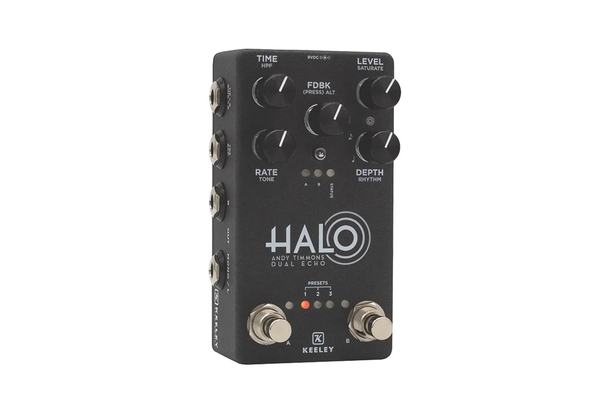There’s a zillion reasons to be excited about the Keeley Halo—a collaboration between Keeley and guitar ace Andy Timmons. For starters, it’s an express-train ticket to Timmons’ carefully honed delay sound: a spacious playground of echoes that dwells partly in the realm of reverb and lets Timmons’ fretwork breathe and gather momentum and size. It’s also a great pedal for players hooked on the possibilities of a dual-delay setup who have space constraints to consider. And it’s a perfect delay for players that want to dabble in multiple delay textures without the headache of programming and managing a million controls and presets.
Doubling Down
While it’s fairly easy to dive headlong into the Halo and get great sounds, the interface is more complex than a simple analog or digital delay. And because so many of the factory presets and delay types are characterized by delay subdivisions, it’s best to get your sea legs by setting the pedal for quarter-note delays. Even in quarter-note mode, though, it fast becomes apparent how much delay-shaping power you have at your disposal.
None of the five primary controls here will surprise experienced delay users. There’s delay time, feedback, effect level, and modulation depth and rate. But pressing and holding the feedback knob gives you access to a high pass filter, a tone control for the delayed signal, a tape saturation control, and the 5-position selector that moves between tape-style, BBD-style, quarter note, and dotted eighth modes as well as Timmons’ own Halo mode that is the pedal’s namesake. The Halo also has stereo ins and outs, a remote connection jack, and an expression pedal jack via which you can control any of the five primary parameters. You can also set up the pedal for tap-tempo functionality and an infinite hold or “freeze” function. Needless to say, Keeley left few stones unturned putting the Halo together.
Happy Toes
Once I got familiar with the Halo’s controls, it was pretty easy to get carried away with its capacity for tone sculpting. The Halo is powerful and spurs creativity. But it’s also easy to get lost in the early going, and if you’re aiming to get the most out of the Halo it’s vital that you embrace presets and, in some cases, a balletic sense of toe dexterity. These are not knocks on the Halo. Setting up and clearing presets is relatively easy, and so is scrolling through them. But practice at working through these footswitch commands is highly advised.
Once you do have the preset dance down, you may find yourself filling them up pretty quickly. Halo gives you the potential for crafting many and varied tones, and you may get hooked on the power of having so many at your disposal.
Timmons’ own Halo settings are lovely. The repeats tend to bloom ever so slightly and are tastefully backgrounded, even at extra-dry effects mixes, and this characteristic makes it a great fit for high-gain pedals. Most voices, in fact, tend to sit nicely with overdrive or fuzz. Both the bucket brigade and the tape delay voices in particular became favorites, largely because they sounded so fat with the addition of virtual tape saturation and darkening from the high-pass filter and tone control. Even in this dusky tone state, the Halo had plenty of room for fuzz and distortion without becoming a mess. This mix of headroom and personality isn’t an easy balance to maintain. Keeley executed that tightrope walk with aplomb here.
The Verdict
Nine times out of 10, a collaboration between a veteran pedal builder and a seasoned session and touring guitarist will yield a very practical piece of kit. The Halo is indeed that. The feature-rich design, dual-function controls, and the fact that it’s packed in a compact enclosure means that there’s a learning curve. And that might dent the aura of practicality for some. Players that like to keep it simple might find the Halo to be a handful, too. But it’s hard to imagine a do-it-all delay more capable than this cooperative effort from two crafty vets.



















